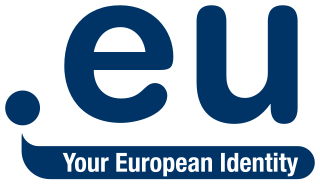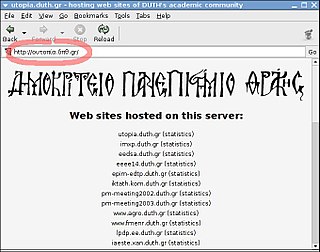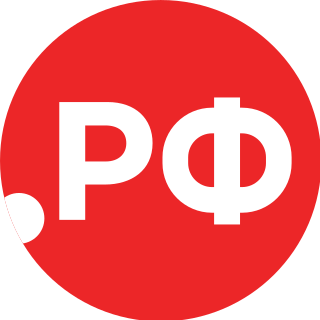
The Internet Corporation for Assigned Names and Numbers is a global multistakeholder group and nonprofit organization headquartered in the United States responsible for coordinating the maintenance and procedures of several databases related to the namespaces and numerical spaces of the Internet, ensuring the Internet's stable and secure operation. ICANN performs the actual technical maintenance work of the Central Internet Address pools and DNS root zone registries pursuant to the Internet Assigned Numbers Authority (IANA) function contract. The contract regarding the IANA stewardship functions between ICANN and the National Telecommunications and Information Administration (NTIA) of the United States Department of Commerce ended on October 1, 2016, formally transitioning the functions to the global multistakeholder community.
A top-level domain (TLD) is one of the domains at the highest level in the hierarchical Domain Name System of the Internet after the root domain. The top-level domain names are installed in the root zone of the name space. For all domains in lower levels, it is the last part of the domain name, that is, the last non-empty label of a fully qualified domain name. For example, in the domain name www.example.com, the top-level domain is .com. Responsibility for management of most top-level domains is delegated to specific organizations by the ICANN, an Internet multi-stakeholder community, which operates the Internet Assigned Numbers Authority (IANA), and is in charge of maintaining the DNS root zone.

In the Internet, a domain name is a string that identifies a realm of administrative autonomy, authority or control. Domain names are often used to identify services provided through the Internet, such as websites, email services and more. Domain names are used in various networking contexts and for application-specific naming and addressing purposes. In general, a domain name identifies a network domain or an Internet Protocol (IP) resource, such as a personal computer used to access the Internet, or a server computer.
A domain name registry is a database of all domain names and the associated registrant information in the top level domains of the Domain Name System (DNS) of the Internet that enables third party entities to request administrative control of a domain name. Most registries operate on the top-level and second-level of the DNS.

The domain name .org is a generic top-level domain (gTLD) of the Domain Name System (DNS) used on the Internet. The name is truncated from 'organization'. It was one of the original domains established in 1985, and has been operated by the Public Interest Registry since 2003. The domain was originally "intended as the miscellaneous TLD for organizations that didn't fit anywhere else." It is commonly used by non-profit organizations, open-source projects, and communities, but is an open domain that can be used by anyone. The number of registered domains in .org has increased from fewer than one million in the 1990s, to ten million in 2012, and held steady between ten and eleven million since then.

.eu is the country code top-level domain (ccTLD) for the European Union (EU). Launched on 7 December 2005, the domain is available for any person, company or organization based in the European Union. This was extended to the European Economic Area in 2014, after the regulation was incorporated into the EEA Agreement, and hence is also available for any person, company or organization based in Iceland, Liechtenstein and Norway. The TLD is administered by EURid, a consortium originally consisting of the national ccTLD registry operators of Belgium, Sweden, and Italy, joined later by the national registry operator of the Czech Republic. Trademark owners were able to submit registrations through a sunrise period, in an effort to prevent cybersquatting. Full registration started on 7 April 2006.
The Internet uses the Domain Name System (DNS) to associate numeric computer IP addresses with human-readable names. The top level of the domain name hierarchy, the DNS root, contains the top-level domains that appear as the suffixes of all Internet domain names. The most widely used DNS root is administered by the Internet Corporation for Assigned Names and Numbers (ICANN). In addition, several organizations operate alternative DNS roots, often referred to as alt roots. These alternative domain name systems operate their own root name servers and commonly administer their own specific name spaces consisting of custom top-level domains.

An internationalized domain name (IDN) is an Internet domain name that contains at least one label displayed in software applications, in whole or in part, in non-Latin script or alphabet or in the Latin alphabet-based characters with diacritics or ligatures. These writing systems are encoded by computers in multibyte Unicode. Internationalized domain names are stored in the Domain Name System (DNS) as ASCII strings using Punycode transcription.
A domain name registrar is a company, person, or office that manages the reservation of Internet domain names.

.xxx is a sponsored top-level domain (sTLD) intended as a voluntary option for pornographic sites on the Internet. The sponsoring organization is the International Foundation for Online Responsibility (IFFOR). The registry is operated by ICM Registry LLC. The ICANN Board voted to approve the sTLD on 18 March 2011. It went into operation on 15 April 2011.
A country code top-level domain (ccTLD) is an Internet top-level domain generally used or reserved for a country, sovereign state, or dependent territory identified with a country code. All ASCII ccTLD identifiers are two letters long, and all two-letter top-level domains are ccTLDs.
Generic top-level domains (gTLDs) are one of the categories of top-level domains (TLDs) maintained by the Internet Assigned Numbers Authority (IANA) for use in the Domain Name System of the Internet. A top-level domain is the last level of every fully qualified domain name. They are called generic for historical reasons; initially, they were contrasted with country-specific TLDs in RFC 920.
The Canadian Internet Registration Authority (CIRA) is the organization that manages the .ca country code top-level domain (ccTLD) for Canada. Its offices are located at 979 Bank Street in Ottawa, Ontario, Canada. CIRA sets the policies and agendas that support Canada's internet community and Canada's involvement in international internet governance. It is a member-driven organization with membership open to all that hold a .ca domain. As of March 2023, there were more than 3.3 million active .ca domains.
.um was the Internet country code top-level domain for the United States Minor Outlying Islands. It was administered by the United States Minor Outlying Islands Registry. Until late 2006 USMIR was housed at the University of Southern California Information Sciences Institute (USC-ISI), which was the original administrator of .us prior to NeuStar absorbing that role.

.so is the internet country code top-level domain (ccTLD) for Somalia. After a long absence, the .so domain was officially relaunched on November 1, 2010, by .SO Registry, which is regulated by the nation's Ministry of Posts and Telecommunications. It was launched through various accredited registrars around the world.

.web is a proposed top-level domain (TLD) that was created and assigned by an auction process to several bidding companies. It was awarded to Nu Dot Co LLC, which is primarily funded by Verisign.

The domain name .рф is the Cyrillic country code top-level domain for the Russian Federation, in the Domain Name System of the Internet. In the Domain Name System it has the ASCII DNS name xn--p1ai. The domain accepts only Cyrillic subdomain applications, and is the first Cyrillic implementation of the Internationalizing Domain Names in Applications (IDNA) system. The domain became operational on 13 May 2010. As of 2014 it is the most used internationalized country code top-level domain, with around 900,000 domain names.
.college is a generic-top-level domain (gTLD) used in the domain name system of the Internet. It was delegated to the Root Zone of the DNS on 10 April 2014, completing the successful application for the string. The .college back-end registry operations are provided by CentralNic. Unlike .edu, .college is open for registration to the general public.

OpenNIC is a user-owned and -controlled top-level Network Information Center that offers a non-national alternative to traditional top-level domain (TLD) registries such as ICANN. As of January 2017, OpenNIC recognizes and peers all existing ICANN TLDs, for compatibility reasons. However, OpenNIC has not yet evaluated and does not hold a formal position on future ICANN TLDs.










